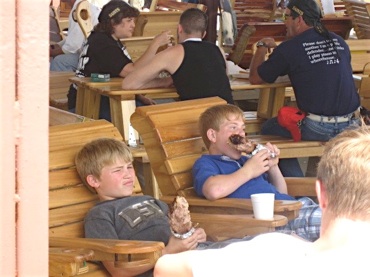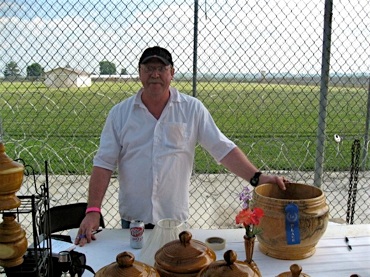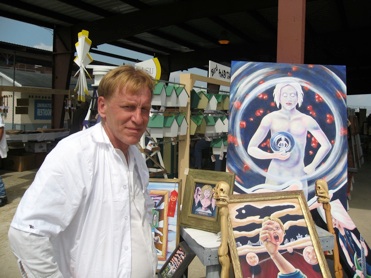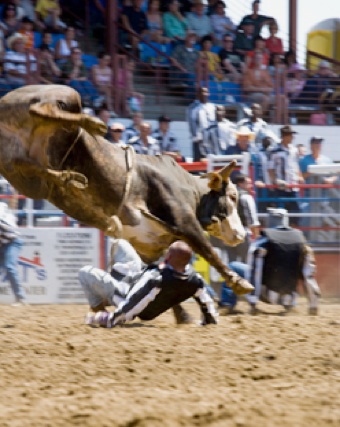10:30 a.m.
Bruce and Emille, both white men in their mid-fifties, are trustees at Angola (xxv). Their table is on the outskirts of the event, the men stand against portable fencing erected to form a perimeter which separates the festival from the “functioning” prison (xxvi). Their table is covered with handcrafted wooden bowls, cups and other containers. Bruce is quick to agree to allow me to make a photograph of him and his craft adorned with a blue ribbon, and tells me about the process of entering “hobbycrafts” into a competition where “hobbycrafts” are evaluated and judged by prison staff and “expert” guest judges. Given the slow start to the day I have plenty of time to explain my project, answer a few of Bruce and Emille’s questions, and ask some of my own.
Bruce and Emille have more than forty years of combined experience with the crafts fair, they were both young men when they arrived at Angola, and both will, most likely, live out the remainder of their lives here. As we talk there is both resignation and resolve in their voices; it is clear that the crafts fair serves a practical and ideological purpose for both men. The crafts fair provides a needed financial resource; the men will earn money to keep and some to send home to the family members on whom they usually depend for financial and emotional support. Throughout the day I hear a number of men explain to potential customers that the money they make will be sent back to family members. They often mention their children. The logic of their rhetoric is clearly structured to discourage the thought that money might be going to cigarettes, drugs, alcohol or other prison “contraband.” The men seem to be aware that part of their role is to counterbalance the images, guided by television, film and the news media, which loom in the subconscious of the lay attendee. In addition to the immediate, or short-term gains--social and economic, Bruce describes what he considers the more significant contribution of the event: Listen.
Trustees of the prison, men who have little hope of leaving the prison, have either resigned or become committed to making Angola their home. “The Warden tells us it’s our responsibility to make sure there are no problems at the event, we know it’s all over if there is.” Bruce clearly conveys the importance of control at the event. The trustees serve as mediators between the “free” and incarcerated world, and they appear to do their best to present a positive image of prison life. Repeatedly throughout the day I am greeted by smiling faces followed by “hello ma’am” or “hi, young lady.” The men are friendly and seem aware of their responsibility in the performance.
Emille, who is currently serving the twenty-sixth year of a life sentence at Angola, has also learned to speak the language of the warden. I asked him what he thought tourists should learn from their experience. He tells me about the freedom he has on the grounds of the prison. He does not escape, even though his job involves driving outside the prison gates. Emille wants to go home, and believes that reintegration is possible, despite his life sentence. Emille was one of the few men I met who spoke about life after Angola and credits the warden for his positive attitude. After speaking with Emille I get the sense that his resilience is innate to who he is. Like Bruce, Emille understands that there is significant work to be done to challenge the public opinion about prisoner, which is why he thinks the crafts fair and rodeo should be an international event. He believes the event can have a positive effect: Listen.
Emille has learned well and is a model prisoner, an important sign of a “good prison.” Visitors I spoke with were less sympathetic in their perspectives on the event, specifically when asked about the incarcerated men they met during the event. After a day at Angola and given time at home to reflect on her experience, Angela, a visitor to the event, when asked about her interactions with the men, inadvertently describes to me the process she engaged to reconcile her experience. She begins with a short-lived display of sympathy: “It is easy to feel sorry for them when one sees all the security and the double/triple barbed wire fences,” but, in the same sentence, provides a counter argument to her initial impression: “however, one only has to remember why those guys are there, and then one doesn’t feel so sorry for them. They are some of the worst, most dangerous criminals in the state of Louisiana, and they are in prison for a reason.”
Although it is clear that Angela’s visit to the prison caused her to pause and momentarily think about the damages of incarceration, the conclusions she draws do little to suggest a change in her beliefs. “But, it seems like this event demonstrates the potential for rehabilitation. Here we are, spending the day inside a prison, with men incarcerated in a maximum-security facility, and it was a very safe experience. Do you think that the event demonstrates the possibility of rehabilitation?” I write back to Angela. A day later I receive another email. Angela writes,
I think that if they [inmates] behave ‘inside’ they deserve a reward like the rodeo and crafts sale. It humanizes things for them and gives them an incentive to behave. It did make me think more about what causes people to become criminals, but the fact is, they broke our state’s laws and hurt people (victims) and/or their families, and the prisoners deserve to be in prison. It is sad for everyone all around.
Our conversation volleys back and forth for a few more rounds, but Angela concedes little ground when it comes to the issue of reintegration, as she is content only viewing the event as a particular form of rehabilitation. In her response, Angela speaks the voice of the status quo and her comments are representative of what I argue is the desired outcome of the event. Angela values this event because it displays the success of the prison system—disciplining offenders—and she is able to witness this success during the rodeo and crafts fair. But, the presentation of “well-behaved inmates” does not mean they deserve to be released from prison, only that they deserve a reward for good behavior. The prison sentence seems to be a non-negotiable factor in her worldview; it is simply the matter-of-fact result of “choosing” to engage in criminal behavior. Although she asks, “what causes people to be criminals?” Angela stops short of engaging her own critical inquiry, and simply resorts to: “they broke the law and hurt people.” In a follow-up email I ask Angela about systemic causes of crime, but we never fully engage this conversation.
Bruce and Emille suggest that the short-term gains of selling items and making a profit pale in comparison to the long-term ideological change and shifts in attitudes toward the prison system that they hope will result from the event. What becomes evident during the event, and in conversation with visitors after returning home is that lasting systemic and/or philosophical changes that could occur at the level of “reentry” or the fourth phase of Turners dramaturgical matrix are unlikely. For many visitors to Angola, the warden’s rhetoric of “reform and redemption” is convincing. The warden is able to convince visitors of the success of his prison through the presentation of his well-behaved men. The men incarcerated at Angola do not attempt escape or cause trouble, as Bruce and Emille point out, because resistant drama is not part of the script. The power of the state to punish is the most prominent item put on display at the crafts fair where docile (read: effectively disciplined) bodies are permitted to interact with the public under limited supervision. Throughout the day I meet dozens of men who play the role of the “good inmate.” Certainly, it is to their advantage to embody the performance.





